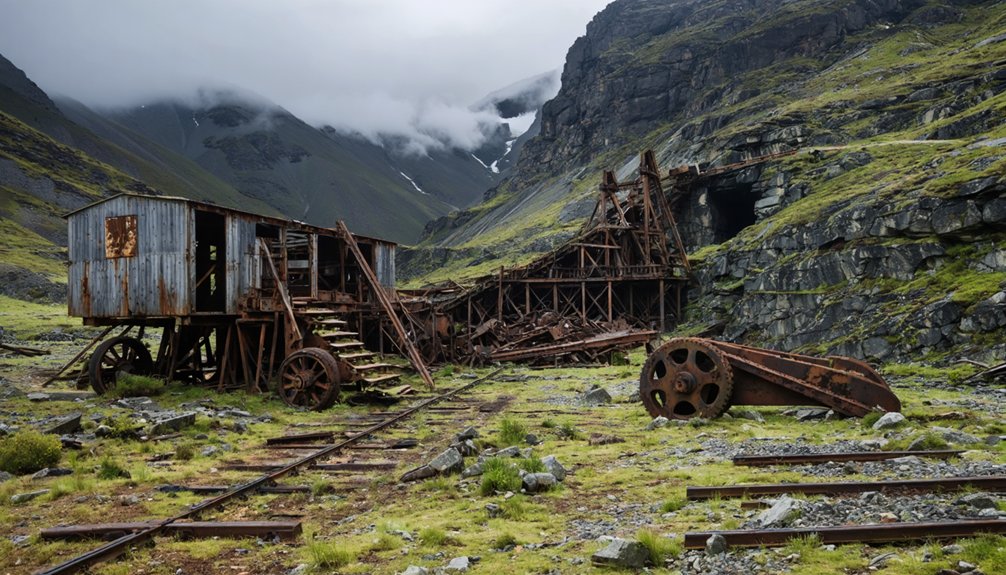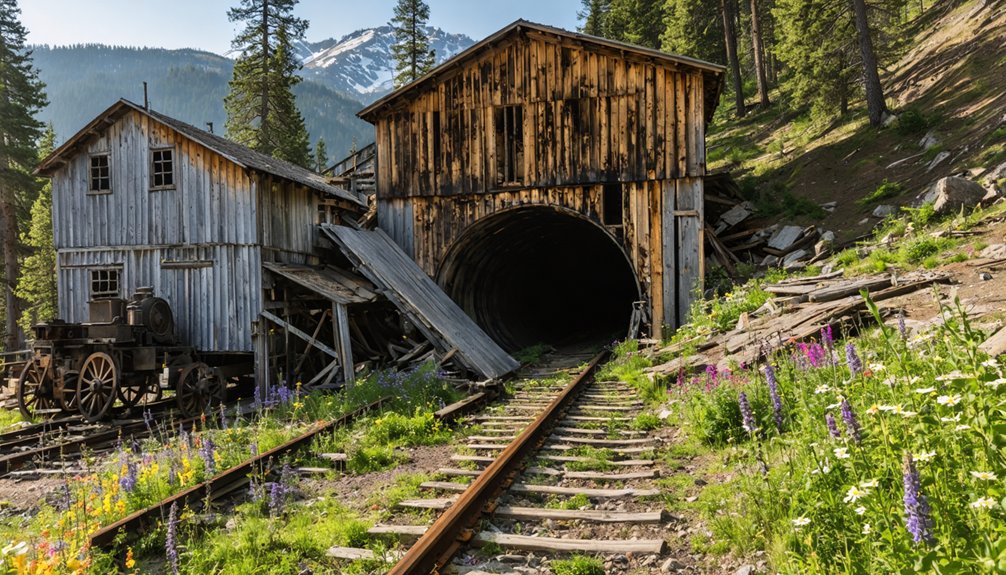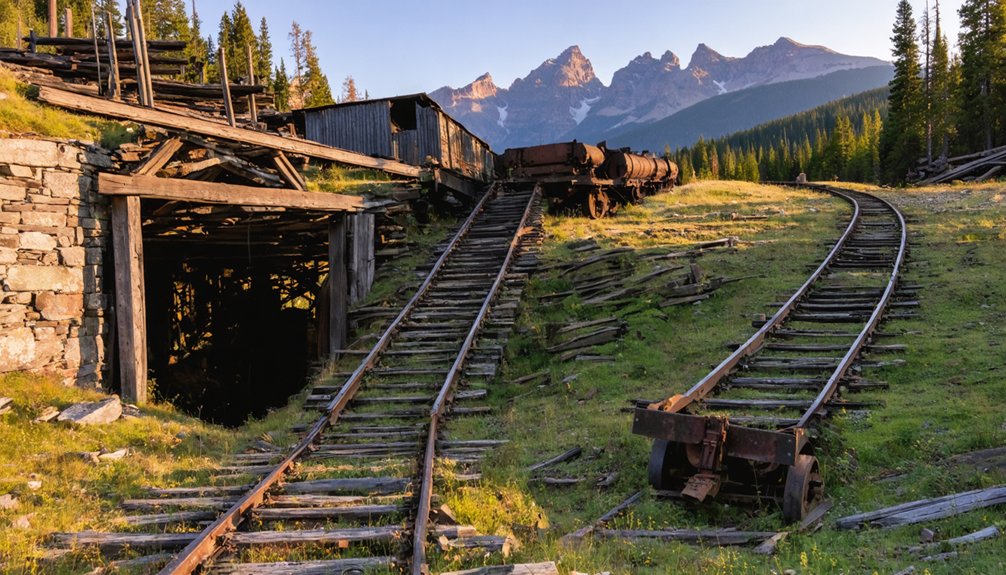You’ll find Black Bear Mine at 11,800 feet in Colorado’s San Juan Mountains, where it operated during the late 19th-century mineral boom. The site, accessible via Black Bear Pass, features remnants of a 820-foot adit system and five prospect claims that once yielded gold, silver, and lead. While the mine’s operations have long ceased, its historic structures and engineering innovations stand as evidence to the region’s mining heritage. The site’s environmental challenges and restoration efforts reveal a complex story of human industry in the high alpine.
Key Takeaways
- Black Bear Mine operated in Colorado’s San Juan Mountains during the late 1800s, featuring an 820-foot adit system for gold, silver, and lead extraction.
- Located at 11,800 feet elevation, the mining community endured extreme conditions while maintaining year-round operations through cooperative living arrangements.
- The site included a 250-ton selective flotation mill and sophisticated engineering solutions for transportation and ore processing.
- Access to the ghost town requires a high-clearance 4×4 vehicle via Black Bear Pass, offering views of historic mining structures.
- Environmental challenges from historic mining operations continue to impact local watersheds and wildlife habitats, prompting ongoing reclamation efforts.
Journey to the San Juan Mountains
As you venture into the San Juan Mountains of southwestern Colorado, you’ll encounter a dramatic landscape stretching roughly 150 miles from Ouray to the New Mexico border.
These rugged peaks, many exceeding 14,000 feet, offer access through historic trails and mountain passes that indigenous peoples and early explorers once crossed. Recent historic rain totals have caused significant flooding in the region, impacting travel conditions. The area encompasses rich mineral deposits evident in the vibrant coloring of the exposed rock faces.
You’ll find the western portion most accessible via Colorado State Road 145 and U.S. 550, where the San Juan Skyway provides a 200-mile loop showcasing scenic landscapes.
The route connects you to Victorian mining towns like Silverton, Ouray, and Telluride, which serve as strategic base camps for mountain exploration.
When maneuvering Cumbres Pass or Wolf Creek Pass, exercise caution – these historic thoroughfares rise above 10,000 feet, presenting challenging conditions that demand respect from modern travelers.
The Birth of Black Bear Mining District
You’ll find the Black Bear Mining District‘s origins in the late 19th century when prospectors staked their initial claims after discovering rich gold and silver deposits in the San Juan Mountains.
The area’s promising mineral yields quickly attracted mining companies and individual operators, leading to the formal organization of the district spanning both Ouray and San Miguel counties. One early success story was the Grizzly Bear Mine which produced nearly $1 million in ore by 1910.
The establishment of local governance and mining regulations followed, alongside the development of essential infrastructure including access roads and basic facilities to support the growing operations. The district’s development was made possible after the Mining Act of 1872 opened the San Juan Mountains for mineral exploration.
Early Gold Rush Era
The Black Bear Mining District emerged during Colorado’s pivotal “Pikes Peak” gold rush of 1858-1859, establishing itself within the mineral-rich terrain of Clear Creek County near Idaho Springs.
Early gold discovery in the surrounding areas near Clear Creek and Bear Creek sparked a wave of prospectors seeking their fortune in the challenging mountain landscape. The district’s connection to Idarado Mine was established when the Treasury Tunnel extended to access Black Bear Mine reserves. Historical documentation shows the mine contained an 820-foot adit that penetrated deep into the mountainside.
You’ll find that these early miners faced considerable mining hardships while developing the region:
- Severe winter conditions with heavy snow and frost impeding year-round operations
- Limited access routes through difficult mountain terrain
- Primitive mining techniques and infrastructure in frontier conditions
- Seasonal constraints forcing operations primarily during summer months
The district’s polymetallic veins yielded gold, silver, and lead, though early production records remain scarce due to the frontier nature of these initial mining ventures.
Mining Claims and Development
During the mid-19th century, Black Bear Mine emerged within the Idaho Springs mining district, establishing itself through five patented claims situated between the Jumbo and Lafayette veins on Clear Creek’s south side.
The Spring Gulch group and surrounding claims formed the core mining operations, reflecting the extensive network of properties in the area.
The mine’s development centered on an 820-foot adit and five prospect holes, reflecting the exploratory nature of this mining venture in Colorado’s Front Range.
Located in sections 34-35, T 3 S, R 73 W, the Black Bear Mine secured its mineral rights through patented claims, providing legal protection for potential gold, silver, and lead extraction.
While the mine never achieved major producer status, it represented the entrepreneurial spirit of Colorado’s mining era. The site, owned by R.C. Marr since 1954, maintained operations from a home office in Arcadia, California.
The rugged terrain and remote location posed typical challenges, limiting the operation’s scale and preventing the establishment of extensive surface infrastructure.
Life at 11,800 Feet: A Mining Community
Life at Black Bear’s extreme 11,800-foot elevation presented you with unrelenting physical challenges, from the thin mountain air that made breathing difficult to the brutal winter conditions that could isolate the community for months.
You’d find miners and their families creating a tight-knit community around the boarding houses and work sites, adapting together to survive the harsh environment that tested human endurance daily.
Despite these hardships, you’d witness how the mining community maintained essential operations year-round, developing infrastructure and support systems that enabled both work and daily life to continue in this remote mountain setting.
Daily Survival Challenges
Surviving at Black Bear Mines’ staggering elevation of 11,800 feet presented miners with daily challenges that tested both physical and mental resilience. Your survival strategies had to account for extreme weather shifts, limited oxygen, and scarce resources while performing demanding physical labor. The discovery of wheat-sized gold nuggets initially drew optimistic prospectors to face these harsh conditions.
The steep, hazardous one-way mountain descent made emergency evacuations nearly impossible during accidents or medical crises.
Resource management became critical to your existence in this harsh environment, where you’d face:
- Chronic shortages of food and supplies due to treacherous delivery routes
- Physical exhaustion from mining activities in thin mountain air
- Limited access to medical care while facing heightened accident risks
- Isolation during winter months when snow blocked transportation routes
You’d need to carefully ration supplies, maintain shelter against brutal storms, and rely on community cooperation to overcome the harsh realities of high-altitude mining life.
Every day required calculated decisions about energy expenditure and resource allocation.
Building Community Despite Isolation
Though perched at a formidable elevation of 11,800 feet, Black Bear Mines fostered a remarkably resilient community where miners and their families forged deep social bonds to combat their geographic isolation.
You’ll find the community’s cultural identity was deeply rooted in shared experiences of both triumph and tragedy. Workers coordinated their efforts in underground operations while their families built informal support networks aboveground.
Despite minimal amenities in company-provided housing, residents developed a cooperative lifestyle that guaranteed mutual survival. They’d gather for communal events, share stories of underground perils, and collectively celebrate the mine’s successes.
This community resilience manifested through multi-generational presence at the site, where children grew up alongside the mine operations. The harsh environment and limited communication with outside towns only strengthened their interdependence and collective spirit.
Engineering Marvels in the Alpine
Operating in the extreme alpine environment of Black Bear Mines required remarkable engineering innovations to overcome the region’s formidable challenges. At elevations exceeding 12,000 feet, engineers devised sophisticated solutions for transportation, water management, and structural stability in the harsh mountain terrain.
- Otto Mears’ engineered mountain roads incorporated switchbacks and shelf designs to navigate steep grades.
- Water diversion systems managed snowmelt while supplying vital resources to mining operations.
- Timber support networks and ventilation shafts guaranteed mine safety in unstable rock formations.
- Specialized infrastructure included high-altitude boarding houses and storage facilities adapted for extreme weather.
You’ll find that every engineering aspect had to account for the severe alpine conditions, from the construction of bridges spanning deep canyons to the implementation of drainage tunnels protecting against mountain runoff and erosion.
Mining Methods and Technology

During the peak of Black Bear Mine’s operations, sophisticated mining methods and technologies transformed the site into a highly efficient extraction complex.
You’ll find evidence of remarkable technological advancements in the 600-foot vertical raise that connected the Treasury Tunnel to old workings, enabling drainage and access to previously mined areas.
The mining techniques implemented were thorough, combining rail systems, ore shoots, and electrical installations to maximize productivity.
The 250-ton selective flotation mill showcased modern processing capabilities, while the innovative tailings suspension bridge provided an effective solution for waste management.
Square set timbering, originally developed by Philip Deidesheimer, guaranteed structural stability throughout the underground operations.
These engineering solutions, coupled with organized labor practices like leasing arrangements, created a mining operation that exemplified the era’s industrial progress.
Challenges of High-Altitude Extraction
While extracting minerals at Black Bear Mines presented lucrative opportunities, the high-altitude environment created formidable obstacles that miners struggled to overcome.
The extreme conditions at elevations above 10,000 feet greatly impacted extraction techniques and operational efficiency. You’ll find that these altitude challenges affected every aspect of mining operations, from worker performance to equipment functionality.
- Thin air reduced worker endurance and machinery effectiveness, limiting productive hours
- Severe temperature swings accelerated equipment wear and created hazardous conditions
- Remote location complicated supply chains and emergency response capabilities
- Seasonal weather patterns forced frequent operational shutdowns
These environmental constraints, combined with complex geological features, made traditional extraction techniques less effective and more costly, ultimately contributing to the site’s eventual abandonment as operational expenses outweighed potential profits.
The Boom Years and Beyond

You’ll find Black Bear’s most intensive mining operations emerged during World War II when the Treasury Tunnel extension, backed by federal funding, connected to rich ore veins beneath historic workings.
Operating at over 11,000 feet elevation, miners faced brutal winter conditions while new infrastructure and mechanized equipment enabled unprecedented mineral extraction.
The post-war era brought peak production under Idarado Mining Company’s management, though activity gradually declined after the Korean War as strategic metal demands decreased.
Peak Mining Operations
Located near Idaho Springs in Clear Creek County, Colorado, the Black Bear Mine operated as an underground precious metals operation with an extensive 820-foot adit and five prospect holes during its peak years.
The mine employed traditional hard rock mining techniques common in late 19th and early 20th century Colorado, focusing on ore extraction through underground tunnels and workings.
You’ll find these key aspects defined the mine’s peak operations:
- Multiple patented claims indicated formal mining rights
- Ore cars transported extracted materials through the adit system
- Lead, silver, and gold were the primary commodities produced
- Infrastructure included strategically placed tunnels following mineral veins
While specific production figures remain undocumented, the mine contributed to Idaho Springs’ mining district prosperity during Colorado’s mineral boom, operating within the broader economic framework of the Colorado Mineral Belt.
Life Above Timberline
Life at the Black Bear Mine presented extraordinary challenges due to its position above timberline in the San Juan Mountains, where harsh alpine conditions shaped every aspect of existence.
You’d find miners enduring extreme isolation while battling year-round snowfall and relentless winds, their mining hardships intensified by the remote location’s limited access to supplies and medical care.
Daily survival demanded alpine resilience, as workers lived in basic company housing with minimal amenities. They’d rely heavily on preserved foods, especially during winter months when resupply became nearly impossible.
Social interactions centered around work shifts and simple recreational activities like card games. Despite mechanization in later years, the unforgiving environment continued to test the resolve of those who called this high-altitude mining camp home, leading many to seek work elsewhere.
Economic Rise and Fall
The Black Bear Mine emerged during Colorado’s late 19th-century mineral boom, primarily extracting gold, silver, and lead from its 820-foot adit system spread across five patented claims.
Located near Idaho Springs, the operation exemplified the region’s economic cycles, attracting substantial mining investments during the post-1859 Pikes Peak Gold Rush.
You’ll find the mine’s economic trajectory followed patterns typical of Colorado’s mining ventures:
- Initial prosperity driven by rich surface deposits and high precious metal demand
- Development of extensive underground infrastructure reflecting investor optimism
- Gradual decline as ore quality diminished and extraction costs increased
- Eventual closure following the familiar boom-bust pattern of smaller operations
While the Black Bear Mine’s total production remains unclear, its impact helped shape Idaho Springs and Clear Creek County’s early development before joining countless other abandoned claims across Colorado’s mining landscape.
Remnants of a Golden Era

Standing as proof to Colorado’s rich mining heritage, Black Bear Mines left behind significant physical evidence of its prosperous operations.
You’ll find the original adits and tunnels carved into the mountainside south of Clear Creek, west of Idaho Springs, where an 820-foot adit marks the mine’s historical significance.
Historic photographs reveal the scale of operations, showing miners and ore cars positioned at the mine entrance, offering glimpses into the past’s industrial might.
The Treasury Tunnel, extended by 7,000 feet during World War II, remains a reflection of the mine’s strategic importance.
Multiple tunnels visible today date back to both early 20th and late 19th centuries, while the 600-foot vertical raise stands as evidence of the complex underground network that once connected this crucial mining operation.
Environmental Legacy and Modern Concerns
While Black Bear Mines once symbolized prosperity during Colorado’s mining boom, its environmental legacy presents significant challenges for modern conservation efforts.
You’ll find the site’s environmental impacts reflected in contaminated watersheds, degraded wildlife habitats, and extensive waste rock piles that continue affecting the ecosystem today.
Current reclamation efforts focus on mitigating these historic mining effects through various initiatives:
- Water quality improvement through drainage control and acid neutralization
- Habitat restoration to support wildlife like black bears, elk, and pumas
- Waste rock relocation and slope stabilization to prevent erosion
- Collaborative projects between federal agencies and conservation groups
These ongoing efforts demonstrate the complex balance between preserving Colorado’s mining heritage and addressing its lasting environmental consequences.
Through careful monitoring and continued remediation, you’re witnessing the gradual healing of this historically significant landscape.
Exploring Black Bear Pass Today
Modern visitors to Black Bear Pass encounter a challenging high-altitude route that showcases both Colorado’s mining heritage and its spectacular alpine terrain.
You’ll need a high-clearance 4×4 vehicle to navigate the 11.1-mile trail, which typically opens from mid-June through early October. The route’s most demanding section, “The Steps,” features exposed switchbacks above Bridal Veil Falls that require experienced off-road driving skills.
Navigating Black Bear Pass demands serious off-road expertise and a capable vehicle to conquer its notorious switchbacks and steep terrain.
As you traverse the pass, you’ll discover remnants of the Black Bear Mine and numerous scenic photography opportunities, including panoramic views of Ingram Basin and the San Juan Mountains.
While the trail offers unparalleled access to Colorado’s mining history, you’ll need to carefully monitor weather conditions and trail status, as the pass can close abruptly due to snow or adverse conditions.
Frequently Asked Questions
What Happened to the Original Mining Equipment After Black Bear Mine Closed?
You’ll find no clear records of the mining relics’ fate, but equipment preservation wasn’t common – companies likely sold machinery for scrap, relocated it, or abandoned it to scavengers.
Were There Any Major Accidents or Disasters at Black Bear Mine?
Based on available mine safety records and historical incidents, there’s no documented evidence of major accidents or disasters at Black Bear Mine in official Colorado mining archives or disaster listings.
How Much Total Gold and Silver Was Extracted From Black Bear Mine?
Like a lost chapter in mining history, you won’t find documented totals for gold extraction or silver yield from Black Bear Mine near Idaho Springs – no official production records exist in available databases.
Did Indigenous Peoples Have Any Historical Connection to the Black Bear Area?
Yes, you’ll find significant indigenous history in the Black Bear area, where Southern Arapaho and Southern Cheyenne tribes maintained cultural significance through hunting grounds and settlements until their forced displacement in 1861.
What Was the Average Miner’s Salary at Black Bear Mine?
You’ll find miners at Black Bear Mine earned approximately $3 to $5 per day during the late 1800s, though wage history shows earnings fluctuated based on ore quality and quantity extracted.
References
- https://coloradosghosttowns.com/Summitville Colorado.html
- https://en.wikipedia.org/wiki/Idarado_Mine
- https://www.tripadvisor.com/ShowUserReviews-g33667-d11853834-r789803382-Tomboy-Telluride_Colorado.html
- https://www.youtube.com/watch?v=5htPQ8WTKMI
- https://www.telluridelodging.com/blog/ghost-town-mining-telluride/
- https://www.ghosttowns.com/states/co/blackbearmine.html
- https://www.interstatesignways.com/post/colorado-s-terrifying-drives-million-dollar-highway-black-bear-pass
- https://www.britannica.com/place/San-Juan-Mountains
- https://www.americansouthwest.net/colorado/san_juan_mountains/index.html
- https://pubs.usgs.gov/bul/0843/report.pdf



